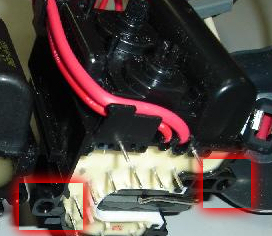I'm trying to solder a flyback transformer back to its board. It is quite heavy and the PCB is battered by age.
Well:
There are at least 8 solderable pins and two screws which secures (or at least on paper, please read below) the transformer onto the PCB.
This is a reference picture:

I already had to reflow some pins once.
Who do you guys think would provide the less stress for the pins?
1) Screwing the transformer onto the PCB and then solder;
2) Solder the pins and then screw the transformer
Well:
There are at least 8 solderable pins and two screws which secures (or at least on paper, please read below) the transformer onto the PCB.
This is a reference picture:

I already had to reflow some pins once.
Who do you guys think would provide the less stress for the pins?
1) Screwing the transformer onto the PCB and then solder;
2) Solder the pins and then screw the transformer
Comment